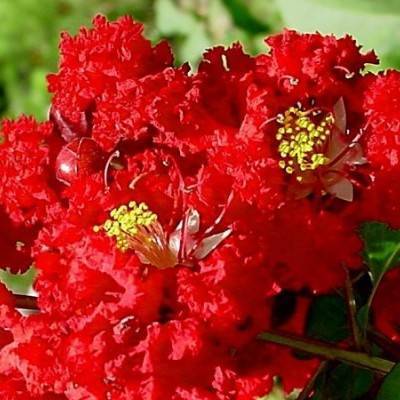
crape myrtle
Lagerstroemia indica 'Whit II' DYNAMITE
Cycle:
Perennial
Watering:
Average
Hardiness Zone:
6 - 9
Flowers:
Flowers
Sun:
Full sun
Leaf:
Yes
Growth Rate:
High
Maintenance:
Moderate
Drought Tolerant:
Yes
Salt Tolerant:
Yes
Care Level:
Medium
watering
Crape myrtle (Lagerstroemia indica 'Whit II' DYNAMITE) requires an average of 1 to 3 inches of water per week during its active growing period, from early spring to mid-fall. During the hottest and driest time of the year, mid-summer, additional watering may be needed. The best time to water is either early in the morning or late in the evening so that the hottest hours of the day won't cause the water to evaporate. Be careful not to overwater the plant, as this could lead to root rot and leaf yellowing. To tell if your crape myrtle needs watering, make sure to check the soil by sticking your finger in it about 1 inch deep. If it feels slightly dry, it's time to water.
sunlight
The Crape Myrtle (Lagerstroemia indica 'Whit II' DYNAMITE) needs a full sun location to produce its best display of flowers. This plant species does best with 8 to 10 hours of direct sunlight each day for optimal flowering. Direct sunlight provides the necessary energy needed by the plant for proper photosynthesis and encourages abundant blooms. Too little sunlight will lead to poor flowering results. In warmer climates, this plant particularly thrives when it is planted in an area with some shade from afternoon sun. Partial shade in the afternoon helps the Crape Myrtle remain in a cooler state during the hottest part of the day and prevents leaf scorch that can occur in direct sunlight. It is important to provide consistent direct sunlight for the entire 8 to 10-hour period for it to be most beneficial to the growth of the plant.
pruning
Crape Myrtle (Lagerstroemia indica 'Whit II' DYNAMITE) should be pruned as soon as flowering finishes, typically between late summer and early fall. Prune away any dead, broken, or diseased branches and then also remove crossed and congested branches to achieve an open growth habit and reduce the chance of disease. In general, a crape myrtle responds well to light pruning. Excessive pruning is not necessary and can make it look unnatural. When removing large branches, it is best to use a 3-cut pruning method of removal: cut 1-third of the way through at the bottom of the branch followed by 1-third of the way through from the top of the branch and then finish by cutting completely through near the base of the branch. This will help reduce tearing of the bark and leave a smooth finish to the tree.
